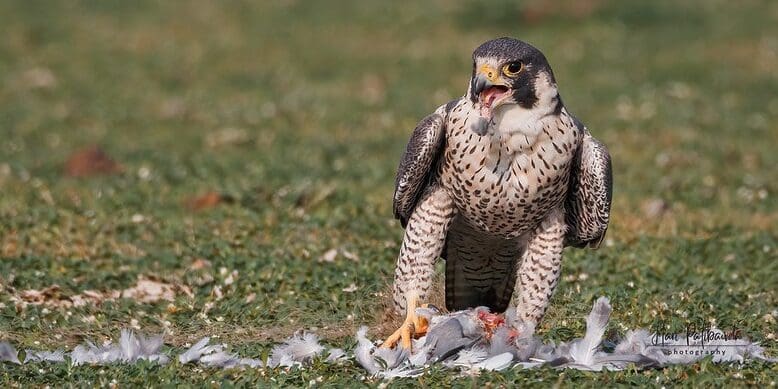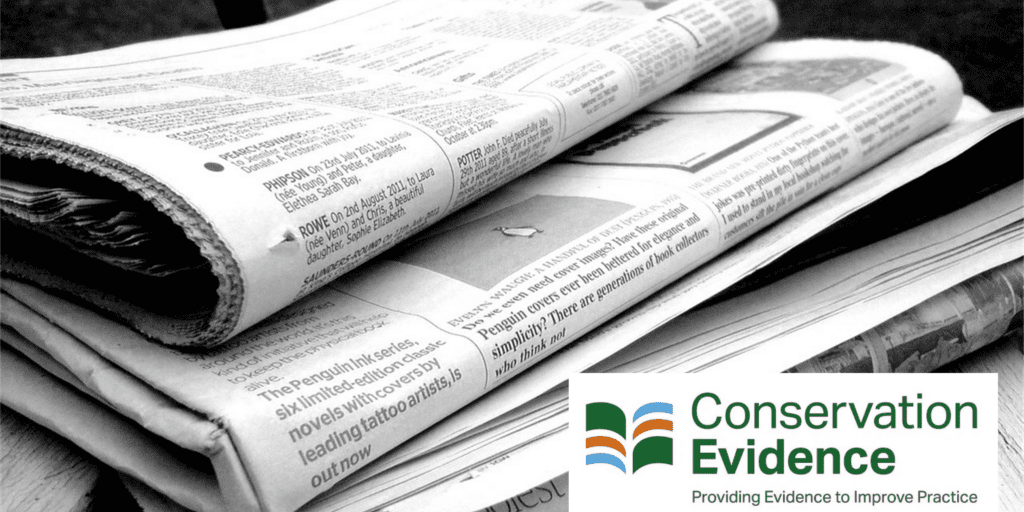Looking out for the little things
Dr Andrew Bladon is a Research Associate at Conservation Evidence and is currently writing the Butterfly and Moth Conservation synopsis.

The list of Conservation Evidence synopses seems to grow longer by the month, and with the reptile synopsis due out later this year [read about it here], we are close to having produced synopses for all vertebrate groups (just freshwater fish left to go). But what about the invertebrates? Here the synopsis list is a little shorter, with just bees and marine benthic invertebrates compiled so far. This reflects many existing biases within conservation: far more nature reserves exist explicitly for the conservation of tigers, gorillas or rhinos than for most invertebrates combined, and far more research papers have tested conservation actions for vertebrates than invertebrates.
But invertebrates are really important, far more so than the bigger and more conspicuous birds, mammals, reptiles and amphibians. Invertebrates underpin every ecosystem on the planet, providing nutrient cycling, water filtration and pollination services, as well as sitting at the base of every food web. Without the invertebrates, we vertebrates would be lost.
In the last couple of years invertebrates, and in particular insects, have hit the headlines with concerns over some dramatic declines (van Klink et al. 2020; Hallmann et al. 2017). As the world wakes up to the importance of these incredible species, the time is right for getting the evidence for their conservation out there.
The systematic search strategy we use means that, although invertebrate synopses have not been written, relevant papers have been piling up in our database from the >650 journals we’ve searched. So much so that the Conservation Evidence database contains over 2,200 articles on terrestrial and freshwater invertebrates, including 599 on beetles, 267 on spiders, 217 on bees and 133 on molluscs. But we have chosen to start with perhaps the most charismatic group: insects with a fascinating life cycle beloved by school science projects, that have captured people’s imagination since the days of Victorian naturalists.
The butterflies and moths, or Lepidoptera, are the second most diverse group of animals on the planet, with over 180,000 species from 126 families. Only the mega-diverse beetles have more individual species. In addition, butterflies and moths have huge ecological importance, as pollinators for a diverse range of flowering plants – including many crops – and as a crucial food source for insectivorous birds and mammals. Butterflies are probably the most popular group of insects, and I like to thing of them as a bit of a gateway drug for getting people interested in other six-legged beasts. They occupy a special place in the public consciousness, and have a correspondingly long history of collecting and recording – especially in the UK and Europe. This means that we often have a better understanding of the ecological requirements of butterflies than most other insects, offering a great starting point for butterfly conservation. Lepidoptera have a diverse life cycle, spending time not only as mobile, nectivorous adults, but also as less mobile, herbivorous caterpillars, and completely immobile eggs and pupae. This means that for butterfly and moth populations to survive and thrive, they need a diverse range of resources in their habitat, which makes them an excellent indicator group for ecosystem health, but also a particular challenge for conservation.

The butterfly and moth synopsis contains evidence from over 300 published papers, reports and book chapters, with 547 individual tests of conservation actions (some papers test more than one action, with ten actions being the record for a single paper in this synopsis!). The synopsis spans nearly 60 years of testing conservation actions, with the earliest data collected in 1964, and the first study published in 1968.
However, the available evidence comes from just 40 countries, with the UK (182 studies) and USA (108 studies) having the most studies. In total, over 90% of studies come from Europe or North America, leaving the rest of the world – including the places with the highest biodiversity – severely under-represented. It’s a similar pattern to that seen in the bird and amphibian synopses (Christie et al. 2020), albeit that the geographical bias for butterflies and moths is even stronger.
What’s striking is that, unlike for the vertebrate synopses where most studies focus on individual species, the majority of Lepidoptera studies report results at the community level – normally species richness or total abundance. While this gives an overview of the community response to conservation actions, it often misses the detailed differences between species, which may be crucial for land managers interested in benefitting particular species of conservation concern.
Of the 135 studies which did test actions for individual species, there is a clear bias towards particularly iconic species – from prairie and pine barren management for the regal fritillary Speyeria idalia and Karner blue Lycaeides melissa samuelis in the USA, to grassland and woodland management for the marsh fritillary Euphydryas aurinia and heath fritillary Mellicta athelia in the UK and China, and captive breeding of species such as the Monarch Danaus plexippus, Puget blue Icaricia icarioides blackmorei, large copper Lycaena dispar batavus and four species of large blue Phengaris spp.. The large blues are a particular conservation challenge, due to their dependence on specific host ant species for their larval development, but the successful reintroduction of the large blue Phengaris arion to southern England, following careful habitat management, represents one of the greatest success stories in butterfly conservation (Thomas 1980; Fox et al. 2015).
When it comes to translocations, patience is often required. A 28-year study on the Gillette’s checkerspot Euphydryas gillettii found that a translocated population remained small for 21 years, before finally undergoing a rapid expansion to colonise new sites. Although the population contracted again, three sites remained occupied, effectively establishing a small meta-population. This study highlights the importance of long-term monitoring of conservation outcomes, especially for butterflies which may undergo natural “boom and bust” population cycles.
Finally, the synopsis has highlighted important gaps in the evidence-base for butterfly and moth conservation. While over half of the studies tested the effectiveness of actions aimed at mitigating the threats posed to butterflies from agriculture, for example by altering grazing or mowing regimes, managing hedgerows and woodland edges, or creating flower-rich habitats within the farmed landscape, we found no studies testing options to mitigate the impacts of climate change and severe weather events. This highlights the importance of the Conservation Evidence database not only for making existing evidence easily available, but also for finding knowledge gaps where more studies are needed to build the evidence base for effective conservation action.
[The synopsis of evidence for butterfly and moth conservation is due to be published later this year.]
Further reading
Christie, Alec P., Tatsuya Amano, Philip A. Martin, Silviu O. Petrovan, Gorm E. Shackelford, Benno I. Simmons, Rebecca K. Smith, David R. Williams, Claire F.R. Wordley, and William J. Sutherland. 2020. ‘Poor Availability of Context-Specific Evidence Hampers Decision-Making in Conservation’. Biological Conservation 248 (August): 108666. https://doi.org/10.1016/j.biocon.2020.108666.
Fox, Richard, Tom M. Brereton, J. Asher, Tom A. August, M. S. Botham, Nigel A. D. Bourn, K. L. Cruickshanks, et al. 2015. ‘The State of the UK’s Butterflies’. Wareham, Dorset: Butterfly Conservation and the Centre for Ecology & Hydrology. https://butterfly-conservation.org/sites/default/files/soukb-2015.pdf.
Hallmann, Caspar A., Martin Sorg, Eelke Jongejans, Henk Siepel, Nick Hofland, Heinz Schwan, Werner Stenmans, et al. 2017. ‘More than 75 Percent Decline over 27 Years in Total Flying Insect Biomass in Protected Areas’. PLOS ONE 12 (10): e0185809. https://doi.org/10.1371/journal.pone.0185809.
Klink, Roel van, Diana E. Bowler, Konstantin B. Gongalsky, Ann B. Swengel, Alessandro Gentile, and Jonathan M. Chase. 2020. ‘Meta-Analysis Reveals Declines in Terrestrial but Increases in Freshwater Insect Abundances’. Science 368 (6489): 417–20. https://doi.org/10.1126/science.aax9931.
Thomas, Jeremy. 1980. ‘Why Did the Large Blue Become Extinct in Britain?’ Oryx 15 (3): 243–47. https://doi.org/10.1017/S0030605300024625.



